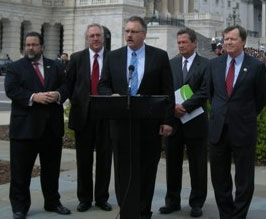 Bipartisan legislation introduced Thursday will help preserve jobs in the renewable energy industry and accelerate the development of cellulosic ethanol, according to its sponsors. The Renewable Fuels Reinvestment Act sponsored by Reps. Earl Pomeroy (D-ND) and John Shimkus (R-IL) unveiled legislation would extend the current Volumetric Ethanol Excise Tax Credit (VEETC), the Small Ethanol Producers Tax Credit and tariff on imported ethanol for five years and extend the Cellulosic Ethanol Production Tax Credit for three years.
Bipartisan legislation introduced Thursday will help preserve jobs in the renewable energy industry and accelerate the development of cellulosic ethanol, according to its sponsors. The Renewable Fuels Reinvestment Act sponsored by Reps. Earl Pomeroy (D-ND) and John Shimkus (R-IL) unveiled legislation would extend the current Volumetric Ethanol Excise Tax Credit (VEETC), the Small Ethanol Producers Tax Credit and tariff on imported ethanol for five years and extend the Cellulosic Ethanol Production Tax Credit for three years.
Congressman Pomeroy said, “At a time when our economy is struggling, we cannot afford to let these tax incentives expire and stymie the growth we have seen in our ethanol industry.”
“Extending the ethanol and cellulosic tax credits helps give much needed certainty to the industry and will continue to help our nation’s energy security,” said Congressman Shimkus.
 Leaders of the Renewable Fuels Association (RFA), Growth Energy and the National Corn Growers Association (NCGA), joined the congressmen in a Thursday afternoon press conference at the Capitol to introduce the bill. Pictured from left to right are RFA President Bob Dinneen, Congressman John Shimkus (R-Ill.), Growth Energy CEO Tom Buis, Congressman Earl Pomeroy (D- N.D.), with NCGA president Darrin Ihnen at the podium.
Leaders of the Renewable Fuels Association (RFA), Growth Energy and the National Corn Growers Association (NCGA), joined the congressmen in a Thursday afternoon press conference at the Capitol to introduce the bill. Pictured from left to right are RFA President Bob Dinneen, Congressman John Shimkus (R-Ill.), Growth Energy CEO Tom Buis, Congressman Earl Pomeroy (D- N.D.), with NCGA president Darrin Ihnen at the podium.
“The extension of VEETC would contribute to energy independence, create and secure thousands of jobs in rural America and allow for a stronger agriculture sector,” said Ihnen, a grower from South Dakota.
Growth Energy just released a study showing that if the tariff on foreign ethanol is allowed to expire at the end of the year, extreme job losses and the loss of billions of dollars in economic activity would follow. The 10 year projection, calculated by the University of Missouri’s Community Policy Analysis Center, found 39,506 jobs would be lost in the first year after the tariff lapses, 115,642 in the second year, and 161,384 in the third year. The decline in economic activity following the lapse of the tariff was calculated at $9.2 billion the first year, $26.4 billion the second year, and $36.7 billion the third year – and remaining in the double digits during the 10-year projection, hitting $21.2 billion in 2021.
“Without the tariff, American taxpayers will be allowing foreign-subsidized ethanol to subvert American companies and American workers,” said Growth Energy CEO Tom Buis. “It would replace our nation’s addiction to foreign oil with dependence on foreign ethanol – and not make our nation one bit more energy secure.”
Joining Reps. Pomeroy and Shimkus as co-sponsors of the bill are 27 other members of Congress. A companion bill in the Senate is expected soon.





 “Passage of the RFRA will provide investors with the long term stability needed to bring next generation technologies to commercialization. Likewise, it allows current ethanol producers to invest with confidence in new efficiencies to further improve upon ethanol’s economic and environmental benefits,” said Renewable Fuels Association President Bob Dinneen. “Representatives Pomeroy, Shimkus and their fellow cosponsors are showing tremendous leadership and foresight. I urge all members of Congress to take this opportunity to learn the real facts about American ethanol production and, ultimately, pass this bill as soon as possible.”
“Passage of the RFRA will provide investors with the long term stability needed to bring next generation technologies to commercialization. Likewise, it allows current ethanol producers to invest with confidence in new efficiencies to further improve upon ethanol’s economic and environmental benefits,” said Renewable Fuels Association President Bob Dinneen. “Representatives Pomeroy, Shimkus and their fellow cosponsors are showing tremendous leadership and foresight. I urge all members of Congress to take this opportunity to learn the real facts about American ethanol production and, ultimately, pass this bill as soon as possible.” Representatives Earl Pomeroy (D-ND) and John Shimkus (R-IL) have called a press conference today to introduce the Renewable Fuels Reinvestment Act (RFRA). The bill would extend the $0.45 Volumetric Ethanol Excise Tax Credit (VEETC), commonly called the blenders’ credit, and the secondary tariff on imported ethanol, as well as the Small Producers Tax Credit and the Cellulosic Ethanol Production Tax Credit.
Representatives Earl Pomeroy (D-ND) and John Shimkus (R-IL) have called a press conference today to introduce the Renewable Fuels Reinvestment Act (RFRA). The bill would extend the $0.45 Volumetric Ethanol Excise Tax Credit (VEETC), commonly called the blenders’ credit, and the secondary tariff on imported ethanol, as well as the Small Producers Tax Credit and the Cellulosic Ethanol Production Tax Credit. The two lawmakers circulated a letter this week to their colleagues seeking co-sponsors. “Our legislation will provide meaningful long-term extensions of these tax credits, giving the industry the certainty it needs to maintain current production and continue to invest and develop the next generation of biofuels,” they wrote.
The two lawmakers circulated a letter this week to their colleagues seeking co-sponsors. “Our legislation will provide meaningful long-term extensions of these tax credits, giving the industry the certainty it needs to maintain current production and continue to invest and develop the next generation of biofuels,” they wrote.



 The plant is located in Madison, Wisconsin and is the latest step in a joint biogasoline research and development effort,
The plant is located in Madison, Wisconsin and is the latest step in a joint biogasoline research and development effort,  Company officials claim the new biofuel can be blended with gasoline in high concentrations for use in standard gasoline engines. The new product has the potential to eliminate the need for specialized infrastructure, engine modifications, and blending equipment necessary for the use of gasoline containing more than 10% ethanol.
Company officials claim the new biofuel can be blended with gasoline in high concentrations for use in standard gasoline engines. The new product has the potential to eliminate the need for specialized infrastructure, engine modifications, and blending equipment necessary for the use of gasoline containing more than 10% ethanol.